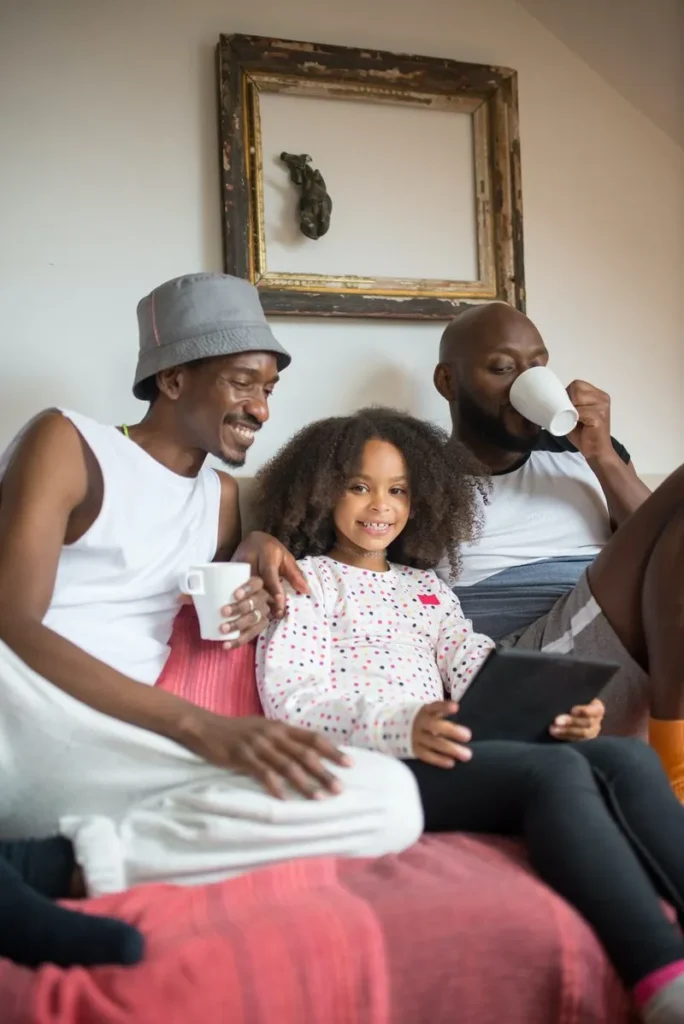The term family has historically most often referred to two parents, a mother and a father, and one or more children. For some people, this dynamic is important and perhaps even the moral way of living. But this is certainly not true for all people or all families. In fact, for many of us, the term family is much more nuanced than that.
This is especially true when we look at LGBTQ families.
What is family?
When we look at dictionary definitions of family, we find phrases like “two or more persons related by birth/blood, marriage, or adoption” and “parents and their children.” This is also true when we take a look at definitions used by many government agencies in the United States (and perhaps other parts of the world).
If you ask a group a people to define family, some of them may include phrases like those listed above, but it’s likely that you’d receive diverse responses. What constitutes a family is highly influenced by culture and religion. And this makes it personal.
In fact, when I’ve asked my students this question, the answers have varied incredibly. Sometimes they include single parents. Or blended families. Sometimes they include extended blood-related family members. Other times they include people they aren’t related to at all, such as friends. Some families include two moms, or two dads, or no parents at all. Many include no children. And some even mention their pets.
The point is, how we define family as individuals can vary drastically from what the dictionary or the government say. And all definitions are valid.
Family Diversity in the United States
There’s increasing diversity in family makeup in the United States. Divorce, remarriage, and cohabitation (people living together unmarried) are all increasing. There are also more childfree families. What do the numbers look like?
- As of 2015, 69% of children live in a two-parent home with 62% living in a married two-parent home. That’s a sharp difference from the 87% of children who lived in a two-parent home in 1960.
- In 1960, 73% of children lived with two married parents in their first marriage. As of 2015, that percentage dropped to 46%.
- There were 7% of children living with cohabitating parents in 2015.
- A huge 26% of children lived with one parent in 2015 whereas only 9% lived with one parent in 1960.
- Unsurprisingly, blended families are on the rise. These are families including remarriage, which include step-parents/step-children.
But what’s been missing from these figures?
LGBTQ families
For many years, parents and caregivers were either identified as married or single. There was no cohabiting indicator. This not only left out a lot of heterosexual couples who remained unmarried, but also the entire population of non-heterosexual families given “same-sex marriage” wasn’t legal in the United States until 2015.
Considering that fact alone, you can see how and why some of the statistics reported above have changed so drastically.
What about LGBTQ families and children?
- It was illegal for same-sex couples to adopt children anywhere in the United States until 1997. The last state to overturn a ban on adoption by gay and lesbian people occurred in 2010. It didn’t become federal law until 2015. That’s only 7 years ago, folks!
- There are more than 11.3 million LGBTQ adults in the United States alone, making up 4.5% of all adults.
- Between 2 and 3.7 million children have at least one LGBTQ parent. Approximately 29% of LGBTQ adults are raising a child under 18.



These families are valid and important. And the more recognition, visibility, support, and acceptance they receive, the healthier their children’s social-emotional development will be.
How to support LGBTQ families
There are many ways that people who don’t belong to the LGBTQ community can support LGBTQ families.
- Use inclusive language. This includes changing our assumptions about family. For example, if you’re talking to a child’s mother, stop assuming there’s a father in the picture. The other parent or caregiver just might be another mother.
- Consider how the LGBTQ community may be left out of conversations, public spaces, media, and other important conversations. Support their inclusion going forward. Simple examples include LGBTQ representation in movies and television shows or in products and advertisements. For example, if you’d find it acceptable for there to be a heterosexual relationship, be willing to accept a non-hetero relationship.
- Be mindful of your own biases, misunderstandings, or prejudices. If someone calls you out on something you’ve done, said, or thought, pause and reflect. Consider how it may be helpful for you to take someone else’s perspective and empathize with their point of view. Could you consider a new way of thinking?
- Support organizations like The Trevor Project, Human Rights Campaign, or Family Equality Council through time or monetary donations. Speak out in support of Pride Month. Attend your local Pride events. Support LGBTQ run organizations.
- Wear Pride clothing and paraphernalia, hang signs, and other public representations of support.
- Share your pronouns in social media or other spaces.
Register for my FREE Intro to Anger Management Course
Are you struggling to manage your anger? If so, then this free Anger Management Course is for you.
References and Recommended Resources
- Family Equality Council (2020). LGBTQ family fact sheet. https://www.familyequality.org/wp-content/uploads/2021/01/LGBTQ-Families-2020-Sheet-Final-clean-version.pdf
- Pew Research Center. (2015, December 17). Parenting in America. Pew Research Center. https://www.pewresearch.org/social-trends/2015/12/17/1-the-american-family-today/#:~:text=Today%2C%20fully%2062%25%20of%20children,and%20just%209%25%20in%201960.
- Rudolph, D. (2017, October 20). A very brief history of LGBTQ parenting. Family Equality. https://www.familyequality.org/2017/10/20/a-very-brief-history-of-lgbtq-parenting/




